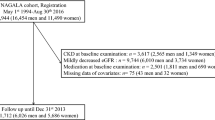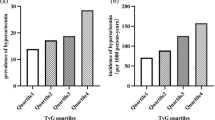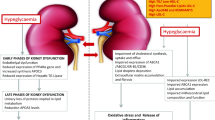Abstract
Aims/hypothesis
We studied the impact of baseline lipid variables on the progression of renal disease in a large nationwide prospective cohort of persons with type 1 diabetes.
Methods
A total of 2,304 adults with type 1 diabetes and available lipid profiles participating in the Finnish Diabetic Nephropathy Study (FinnDiane) were evaluated. Data on progression of renal disease were verified from medical files, and patients were followed for 5.4 ± 2.0 years (mean ± SD).
Results
High triacylglycerol, apolipoprotein (Apo) B, ApoA-II and HDL3-cholesterol concentrations predicted incident microalbuminuria. Progression to macroalbuminuria was predicted by high triacylglycerol and ApoB. When AER was entered into the model, triacylglycerol was no longer an independent predictor, but when persons with normal AER and microalbuminuria at baseline were pooled, triacylglycerol, HbA1c, male sex and AER were all independent predictors of renal disease. High total cholesterol, LDLcholesterol, non-HDL-cholesterol and triacylglycerol as well as low HDL cholesterol, HDL2-cholesterol, ApoA-I and ApoA-II concentrations were predictive of progression to end-stage renal disease. However, when estimated GFR was entered into the model, only total cholesterol remained an independent predictor of progression.
Conclusions/interpretation
Lipid abnormalities, particularly high triacylglycerol concentrations, increase the risk of progression of renal disease.
Similar content being viewed by others
Références
Hadjadj S, Duly-Bouhanick B, Bekherraz A, et al. (2004) Serum triglycerides are a predictive factor for the development and the progression of renal and retinal complications in patients with type 1 diabetes. Diabetes Metab 30: 43–51
Thomas MC, Rosengård-Bärlund M, Mills V, et al. (2006) Serum lipids and the progression of nephropathy in type 1 diabetes. Diabetes Care 29: 317–22
Shepherd J, Kastelein JJ, Bittner V, et al. (2007) Effect of intensive lipid lowering with atorvastatin on renal function in patients with coronary heart disease: the Treating to New Targets (TNT) study. Clin J Am Soc Nephrol 2: 1131–39
Keech A, Simes RJ, Barter P, et al. (2005) Effects of long-term fenofibrate therapy on cardiovascular events in 9,795 people with type 2 diabetes mellitus (the FIELD study): randomised controlled trial. Lancet 366: 1849–61
Author information
Authors and Affiliations
Corresponding author
Rights and permissions
About this article
Cite this article
Cariou, B. Hypertriglycéridémie et néphropathie chez le diabétique de type 1: acteur ou marqueur ?. Diabetol. Notes Lect. 2, 7–8 (2010). https://doi.org/10.1007/s13116-010-0037-z
Published:
Issue Date:
DOI: https://doi.org/10.1007/s13116-010-0037-z




